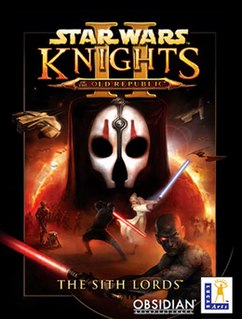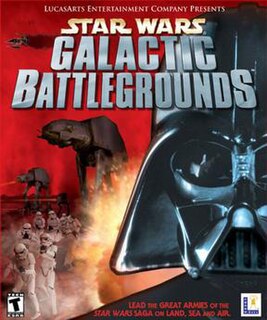Related Research Articles

LucasArts Entertainment Company, LLC, d/b/a LucasArts, is an American video game publisher and licensor. Until 2013, it was also a video game developer. LucasArts is best known for its graphic adventure games, as well as games based on the Star Wars and Indiana Jones franchises. Its headquarters are in San Francisco, California.

Star Wars Jedi Knight II: Jedi Outcast is a first and third-person action game in the Star Wars: Jedi Knight series released in 2002. The Microsoft Windows and OS X versions were developed by Raven Software, and the Xbox and GameCube versions by Vicarious Visions and published by LucasArts with the OS X version was published by Aspyr. Powered by the id Tech 3 game engine, the game primarily revolves around ranged and melee combat, with the player capable of wielding classic Star Wars weapons such as blasters, lightsabers and Force powers.

Star Wars Jedi Knight: Dark Forces II is a 1997 first-person shooter video game developed and published by LucasArts for Microsoft Windows. It was later re-released on Steam in September 2009, and again in 2015 on GOG.com. The game is set in the Star Wars fictional universe and is a sequel to the 1995 game Star Wars: Dark Forces. Jedi Knight was very well-received by critics.

Star Wars Jedi Knight: Jedi Academy is a 2003 first- and third-person shooter action video game set in the Star Wars universe, and is the latest entry in the Star Wars: Jedi Knight game series. It was developed by Raven Software and published by LucasArts in North America and by Activision in all other territories worldwide. The game was released for Microsoft Windows and OS X in September 2003 and for Xbox in November 2003, and received positive reviews.

Star Wars: Knights of the Old Republic is a role-playing video game set in the Star Wars universe. Developed by BioWare and published by LucasArts, the game was released for the Xbox on July 15, 2003, and for Microsoft Windows on November 19, 2003. The game was later ported to Mac OS X, iOS, and Android by Aspyr, and it is playable on the Xbox 360 and Xbox One via their respective backward compatibility features.

Kyle Katarn is a fictional character in the Star Wars expanded universe, who appears in the five video games of the Jedi Knight series, the video game Star Wars: Lethal Alliance, and in several books and other material. In the Jedi Knight series, Katarn debuts in Star Wars: Dark Forces, appears in Star Wars Jedi Knight: Dark Forces II, is one of two playable characters in Star Wars Jedi Knight: Mysteries of the Sith, appears in Star Wars Jedi Knight II: Jedi Outcast and is a major NPC in Star Wars Jedi Knight: Jedi Academy.

Star Wars Knights of the Old Republic II: The Sith Lords is a role-playing video game developed by Obsidian Entertainment and published by LucasArts. It is the sequel to BioWare's Star Wars: Knights of the Old Republic and was released for the Xbox on December 6, 2004, for Microsoft Windows on February 8, 2005, and OS X and Linux on July 21, 2015. Like its predecessor, it is set in the Star Wars universe 4,000 years before the events of the film Episode I: The Phantom Menace and is based on the d20 System developed by Wizards of the Coast. The game uses the Odyssey Engine, which was originally used in Knights of the Old Republic. The plot first started being written before the original Knights of the Old Republic was released, and development began in October 2003, after BioWare offered Obsidian their Star Wars license due to being confident in their previous work.

Star Wars: Galactic Battlegrounds is a real-time strategy video game set in the Star Wars universe. It was developed by Age of Empires developer Ensemble Studios and LucasArts. It was released in November 11, 2001. An expansion pack, Clone Campaigns, was released in May 14, 2002, adding two new factions and campaigns. Later that year, both Galactic Battlegrounds and Clone Campaigns were released in a box set, Star Wars: Galactic Battlegrounds Saga.

Kreia is a fictional character and party member in Obsidian Entertainment's Star Wars Knights of the Old Republic II: The Sith Lords. She is a blind Force-sensitive who forms a "bond" with the player character, the Jedi Exile, through the Force. Kreia sets herself up as the Exile's mentor, and rejects the divide of the light and dark side of the Force, as well as the predestination the Force entails. By the game's end, it is revealed she is the Sith Lord Darth Traya and is planning on destroying the Force, and she becomes the final boss of The Sith Lords. Kreia makes no more appearances in Star Wars fiction, though a miniature by Wizards of the Coast was released in August 2008, and she appears as an obtainable character in Star Wars: Galaxy of Heroes

The Star Wars franchise has spawned over one hundred computer, video, and board games, dating back to some of the earliest home consoles. Some are based directly on movie material, while others rely heavily on the non-canonical Star Wars expanded universe.
Jedi is a game engine developed primarily by Ray Gresko for LucasArts. It is extremely similar to the Build engine used in Duke Nukem 3D. While not a true 3D engine, it supported a three-dimensional environment with no limitations in the 3rd dimension (Z). In Doom, environments or levels were limited to existing in the X-Y plane only – levels were laid out two-dimensionally: while floor and ceiling heights could differ, areas could not overlap vertically. The Jedi Engine had support for areas or rooms on top of one another, a trait that it shared with the Build engine. In the Dark Forces revision of the engine, the renderer could not display two rooms situated on top of each other at the same time. This capability was added for Outlaws.

Peter N. McConnell, also known as Peter Mc, is an American video game composer and musician, best known for his work at LucasArts and for composing the soundtracks for every Sly Cooper game since the second installment.

Star Wars Miniatures is a 34mm scale collectible miniatures tabletop game based on the Star Wars fictional universe that was produced by Wizards of the Coast. The game was originally released in September 2004 and continued production until May 2010. Star Wars Miniatures players build point-based squads from one of ten different in-universe factions then conduct battles between those squads. The game mechanics are a simplified version of the d20 roleplaying game system. Multiple maps, scenarios, and set themes from different settings and time periods from within the Star Wars universe are available.
The LucasArts Archives are a series of CD-ROM personal computer game re-releases and compilations from publisher LucasArts.
The Star Wars: Knights of the Old Republic series, often abbreviated as KotOR, is a RPG video game series and subsequent comic book series based on the fictional universe of Star Wars by George Lucas. The first and third video game installments were developed by BioWare, while the second was done by Obsidian Entertainment per LucasArts' request. All were published by LucasArts. The comic series was published by Dark Horse Comics. This series acts as a prequel to the video games.
Star Wars: Jedi Knight is a first-person shooter and third-person shooter video game series set in the fictional Star Wars expanded universe. The series focuses primarily on Kyle Katarn, a former Imperial officer who becomes a Jedi and an instructor at the Jedi Academy.

Star Wars: The Old Republic is a massively multiplayer online role-playing game (MMORPG) based in the Star Wars universe. Developed by BioWare Austin and a supplemental team at BioWare Edmonton, the game was announced on October 21, 2008. The video game was released for the Microsoft Windows platform on December 20, 2011 in North America and part of Europe. Early access to the game was granted one week before release, on December 13, 2011, for those who had pre-ordered the game online; access opened in "waves" based on pre-order date.

Star Wars Jedi Knight: Mysteries of the Sith is an expansion pack for the 1997 first-person shooter Star Wars Jedi Knight: Dark Forces II. It was developed and published by LucasArts, and released on February 17, 1998. The expansion includes a single-player mode and fifteen multiplayer maps. The multiplayer mode allows up to eight players to play online or over a Local area network. In 2009, it was re-released onto Steam, along with its predecessors and sequels.
References
- ↑ Lua in Grim Fandango
- ↑ Chris Jensen (1999). "Indiana Jones Interview". CheckOut Games (via Internet Archive). Archived from the original on 27 January 2000. Retrieved 7 April 2010.
- ↑ Adding Languages to Game Engines
| This video game software-related article is a stub. You can help Wikipedia by expanding it. |